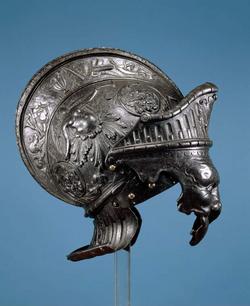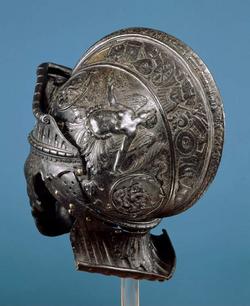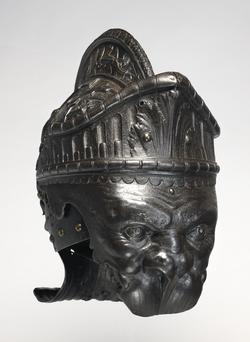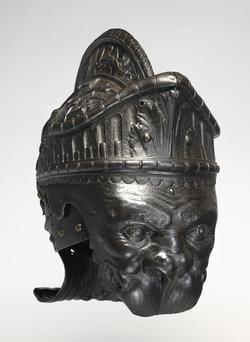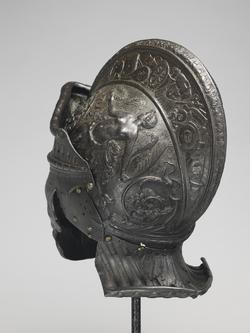Current Location: Gallery 31 (Armoury)
Maker(s)
Armourer:
Negroli, Filippo
(Perhaps)
Entities
Categories
Description
Burgonet, for parade use, with embossed, chased and counterfeit-damascend classical decoration. Formed of a one-piece skull with a pivoted 'visor', an incomplete pair of cheek-pieces, and a neck-defence of one lame. The skull has a high, medial comb, extending from the brow to the nape. The crest of the comb is decorated to either side with acanthus leaves, embossed and chased in low relief. Each side of the comb is decorated between raised ribs with a panel of trophies including arms and armour, musical instruments, a ewer, a basin and a mask, all embossed and chased in relief, and retaining traces of counterfeit-damascened gold ornament. The panel on the right side includes an open book, counterfeit-damascened with the Greek inscription (By these things to the stars). Each side of the skull is decorated with a central winged, nude, female demi-figure with a skirt of acanthus from which a pair of adorsed acanthus volutes terminating in flowerheads issue, all embossed and chased in high relief. The figure on the right side represents Fame, and the figure on the left side, Victory. The skull is decorated around the nape with a rounded rib, divided into short sections by numerous transverse grooves and superimposed on a broader, flat rib. The lower edge of the skull is cut away at the front to form a shallow, arched face-opening. Each side of the face-opening is pierced with a rivet-hole for the attachment of a missing brow-plate. The lower edge of the skull has a shallow, concave cut-out at each side to accommodate the cheek-pieces. The apex of each cut-out is itself cut with a shallow, rectangular notch to accommodate the internal hinge of the cheek-piece. The hinge is lobed around each of the pair of rivets that secure it to skull and cheek-piece respectively. The rivets that secure it to the skull are externally flush and of iron. The rear one on the right side is missing. The rivets that secure the hinge to the cheek-piece are round-headed and of brass. Each cheek-piece has a convex upper edge, matching the profile of the cut-out at the side of the skull, which it overlaps. The rear edge of the cheek-piece is decorated with a short continuation of the embossed rib that runs around the nape of the skull. The cheek-piece is pierced just in front of the rib with four circular ventilation-holes arranged in a lozenge-formation around a further such hole. The lower front corner of the cheek-piece is cut away in a concave curve with a roped inward turn accompanied by a recessed border. The straight lower edge of the cheek-piece is bordered by five round-headed brass rivets, arranged as a row of three with one located below each of the outer ones. Both of the lower rivets are now missing on the right cheek-piece, and both of the front ones on the left. Some or all of these rivets originally served to secure the missing lower extension-plates of the cheek-pieces which probably met and were fastened together at the chin. The lower edge of the skull is cusped and flanged outwards at the centre of the nape, and lobed to either side of it to receive the modern, round-headed, brass rivets with circular, internal washers that attach the overlapping neck-defence. Later holes for three further rivets at either side are pierced in both the lower edge of the skull and the upper edge of the neck-defence. All are now vacant except for the inner one on the left side which is occupied by a round-headed brass rivet that has, however, broken out of the hole in the skull. The central cusp of the lower edge of the skull, which is split and bent, is pierced with three rivet-holes of which the left one is occupied by an externally-flush rivet of iron. The neck-defence of one plate curls outwards at its lower edge which is obtusely pointed at its centre. The point is pierced with a later hole that has broken out to the edge. The edge is pierced to either side of this hole with a pair of later smaller holes, possibly for wiring purposes. The neck-defence is decorated at its upper edge with a series of scallops emphasised by pairs of punched crescents, and below them with deep longtitudinal gadroons interrupted at the centre by acanthus leaves all embossed and chased in relief. Attached by modern pivots at either side of the skull, just behind the hinges for the cheek-pieces, is a one-piece 'visor'. The pivots take the form of brass-capped, round-headed iron rivets with octagonal, internal washers. Pierced in both the skull and the 'visor' just in front of the left pivot is a further hole which may at one time have served as a pivot-point. The hole in the 'visor' is plugged with an externally-flush rivet, while that in the skull remains vacant. The hole in the 'visor' for the right pivot has broken out and been repaired with an internal patch secured by two iron rivets. The 'visor' is decorated with a lion's mask beneath an approximation of a gladiator's visor, in both cases embossed and chased in high relief. The 'gladiator's visor' is of prow-shaped form with a bold, inward, partial turn at its upper edge, divided into short sections by numerous transverse grooves and scrolled at its ends. Its lower edge is bordered by a rounded rib likewise divided into short sections by transverse grooves and superimposed on a broader, flat rib which is bordered at its lower edge by a series of scallops emphasised by pairs of punched crescents. The intervening space is filled with upward-directed, vertical gadroons interrupted at the centre by acanthus leaves. The centre of the 'gladiator's visor' is pierced top and bottom with a pair of later holes. The lower pair are occupied by modern, round-headed, brass rivets. A hole at the centre of the brow of the lion's mask is occupied by a smaller, modern, round-headed iron rivet. The elaborately-shaped lateral and lower edges of the 'visor' are flanged inwards.
Notes
History note: The helmet was acquired about 1935 by a dealer called Jones at an auction sale of 'theatrical junk', and taken to Sir James Mann for identification. In 1936 it was sold by Foster's Sale Room of Pall Mall, London, to Captain R. P. Johns who in 1937, after some six months, sold it for £200 to Mr John Hunt from whom it was acquired by the Fitzwilliam Museum in the following year. According to a statement published by Charles R. Beard in 1945, the helmet had 'been in England for the better part of a century'. Francis H. Cripps-Day claimed that it had come from the collection of the 1st Lord Amherst of Hackney (1835-1909). It did not, however, appear as part of the Amherst Collection sold by Christie's, London, 11 December 1908.
Legal notes
Given by the Friends of the Fitzwilliam Museum with a contribution from the National Art Collections Fund
Measurements and weight
Depth: 29.3 cm
Height: 31.4 cm
Weight: 2.79 kg
Width: 20.2 cm
Acquisition and important dates
Method of acquisition: Given
(1938-07-13)
by
The Friends of the Fitzwilliam Museum
Dating
16th Century, Mid
Circa
1540
CE
-
1545
CE
Note
The cheek-pieces must be recognised as old replacements since the quality of their workmanship does not match that of the other elements of the helmet. The 'visor' must originally have been fixed in the raised position since it lacks the apertures for vision that would have been essential if it had been fixed in the lowered position as it now is.
The helmet has a russet colour with traces of gold counterfeit damascening on the comb.
The present piece closely resembles a burgonet formerly in the armoury of the Archduke Ferdinand II of Tirol at Schloss Ambras and now in the Hof jagdt- und Rüstkammer, Vienna (Inv. No. A693), which is attributed to Filippo Negroli of Milan and has, since about 1565, been associated with a circular shield bearing, among other inscriptions, the Greek motto (To the stars through these). It also bears an abbreviated Latin text which is interpreted as indicating that the helmet and shield were made for the Emperor Charles V to commemorate his second campaign against the Turks in Algeria in 1541 (Ortwin Gamber & Mattheus Pfaffenbichler, Leibrustkammer II, 1990, pp.45-7, pl.13). An incomplete burgonet of a very similar design is preserved in the Metropolitan Museum of Art, New York (Acc. No. 04.3.223). A burgonet in the same collection (Acc. No. 17.190.1720), signed by Filippo Negroli and dated 1543, is of a different form to the present example, but shows very similar decoration.
For discussions and illustrations of the work of the Negroli family, see B. Thomas & O. Gamber, 'L'Arte dell'Armatura', Storia di Milano, Vol. XI, Milan, n.d. [1958], pp. 697-841; and L.G. Boccia & E.T. Coehlo, L'Arte dell'Armatura in Italia, Milan, 1967.
School or Style
Renaissance
Components of the work
Skull
composed of
low-carbon steel
( around 0.1% carbon. See Documentation, Williams, 1999 and 2002)
Rivets
composed of
brass (alloy)
( modern)
iron (metal)
Neck Plate
composed of
low-carbon steel
Visor
composed of
low-carbon steel
Rivet Caps
composed of
brass (alloy)
Cheek-pieces
Decoration
Parts
Ribs
Techniques used in production
Hammering
: Formed of a one-piece skull with a pivoted 'visor', an incomplete pair of cheek-pieces, and a neck-defence of one lame; hammered, shaped, riveted, with embossed, chased and counterfeit-damascening decoration, pierced ventilation-holes, recessed borders and raised ribs
Forming
References and bibliographic entries
Related exhibitions
Identification numbers
Accession number: M.19-1938
Primary reference Number: 18563
Stable URI
Audit data
Created: Saturday 6 August 2011
Updated: Tuesday 16 March 2021
Last processed: Tuesday 13 May 2025
Associated departments & institutions
Owner or interested party:
The Fitzwilliam Museum
Associated department:
Applied Arts
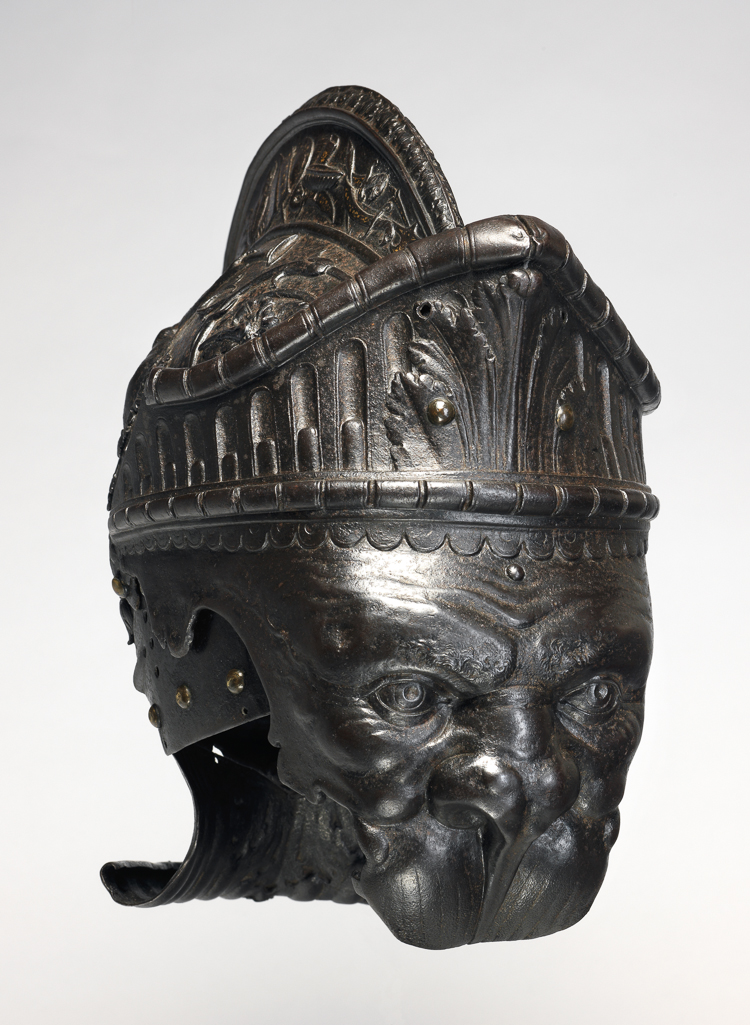
 IIIF Manifest
IIIF Manifest
